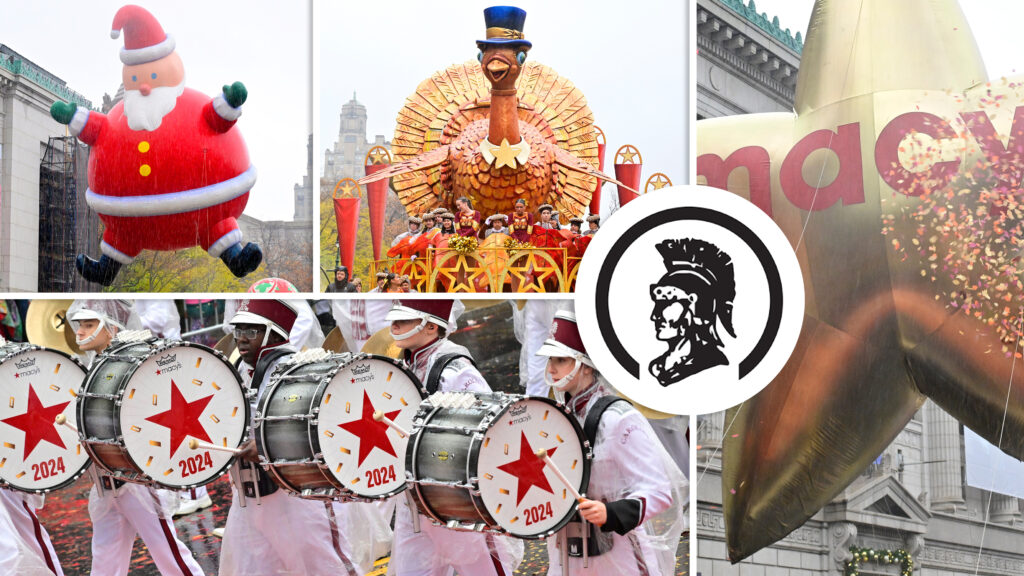Gregory Bruce contributed the following story about St. Rita’s Brassmen, one of the most successful corps of a few decades ago. Please take this, if you will — and begin by suspending your judgment and disbelief just as you would while entering a movie complex before sitting down to watch the newest blockbuster. In the years prior to DCI, the world for a drum corps participant was a much different place than it is today. So different, it’s practically unbelievable. Picture a Friday night on a very busy Atlantic avenue in Brooklyn, N.Y. It is just about 7 pm, it’s August and the year is 1969. Angle the camera down on that broad avenue bisected by a median under which runs the famed “A” train. In silhouette backlight a White Castle hamburger franchise on one corner and a Carvel Ice Cream stand on the opposite corner. You will see figures on the sidewalks. Two-by-two, four in a group and even eight or more — all somehow ignoring the traffic and crossing that avenue with one destination: The big green doors of St. Rita’s Youth Center. Many wear similar lightweight red jackets emblazoned with vertical black and white stripes. They are white and black and Hispanic; they are young men and women who represent virtually every area of the economic, social and ethic spectrum that could be found in New York City at that time. They are members of the St. Rita’s Brassmen. Most of the youngsters have known each other for at least two or three years. Most in the horn line began learning how to play their respective instruments perhaps just months before that — the same with the drummers. Most everything back then and the years before was learned on the fly. Very few corps members could read a score. The portable technology available was limited to the mostly monophonic cassette player. Scores and repertoires were learned by rote. Because our horn line was so small, there were no real “section captains,” and discipline was maintained by two rules of law that went by one name. His name was Carmen Cluna. Much has been written and spoken about this singular individual. For me, a rebellious, smart-mouthed know-it-all, the most difficult thing I ever did was learn how to listen to Carmen. After seeing with my own eyes how he could take what could only be called a ragtag group of boys and girls, dress them down during hours and hours of nothing but repetitive motion, then dress them up in spectacular scarlet, black and white and without hesitation spirit them off to a distant town like Kenosha, Wis., and set them loose against some of the country’s best corps at the time, I knew that this guy was the best. And I — like the rest of the people there that night — would follow his orders, not because he gave them but because they worked. But this is about a time in drum corps history, and what a time it was. Kids, you might want to ask your parents about the mid-to-late 1960s in America. I don’t think they teach the real history of that time in most schools these days. Unrest brewed on so many levels all over the country. But at that time during the summers, rented Trailways and Greyhound buses cruised the Interstates filled with boys and girls, followed closely by chaperones and quartermasters. The only enemy we — or any drum corps — faced was the weather and the hated judges. Sure, there were some rivalries, real and imagined. Some corps really didn’t like us. I personally really didn’t like some corps — they rubbed me the wrong way and they didn’t have the “class” that we so studiously exhibited. But we were sheltered from the outside world. Our world was drum corps. We ate it, slept it and drank it. Inside the spacious rehearsal hall, early arrivals can be heard warming up or doing their pre-rehearsal ritual on that always overly warm New York August night: A lone mellophone player can be heard testing himself with the familiar opening notes of Gershwin’s “Concerto in F.” The clipped slap of leather-against-palm of the rifle team echoed off the high windows. There’s the occasional high-pitched call from one of the color guard to the other as they enter and spy each other. Add to that the laughter and an ease of camaraderie that belies the fact that these young people have just returned days before from a 2,500-mile round trip to the nation’s heartland. They had met and held their own against a contingent of corps most had only heard on recordings from that company once called Fleetwood. Again, kids — ask your parents about “recordings.” There was no evident fatigue. Instead, there was a sense of urgency of the job to come. The World Open Championship was less than a week away and there was work to be done. Very young people populated drum corps when I was marching. St Rita’s was no exception. During the winter months (the off-season if you will) we practiced Friday for music and Sunday evenings for drill. Friday evenings we spent at the hall and we rehearsed at a place known as the Armory on Sunday nights. The Armory was actually a military facility that housed trucks and weaponry and was not easy to get to. To explain the NYC transportation system is a book chore in itself! Needless to say, with five boroughs separating most members, travel time to and from rehearsals could add up to as many as three to four hours. No kidding! If any ensemble section competed in singles or quartet competitions during those months, they rehearsed on their own. We all took our instruments home with us and most were quite diligent about practicing there — to the dismay of most parents, family members, neighbors and friends. The corps in its three incarnations was only around for a total of 10 years. During the winter, we went to school. During the summer months, many of us worked part-time jobs. Thursday nights we ran a bingo to raise money for the corps — I a truly believe we were the first to do this. We were a destitute organization when St. Joe’s gave the Patron Cadets the boot at the start of 1969 (We had been together from 1963). The money raised that first winter outfitted the corps from top to bottom — new uniforms, new horns (in G, thank you) from Olds, and new drums by Ludwig; including tympani and Zildjian cymbals. Rifles, flags and poles, harnesses, sticks, a truck – well, you get my drift. Hence the famed Wes Hobby would introduce us as, “The Cinderella corps from Brooklyn, New York.” The World Open was still pretty new. It had begun to replace the really big shows in importance. The VFW Nationals was one. The CYO Nationals was the other. I know New York State always had an American Legion Championship. And there were “circuits.” The New York Daily News would sponsor a show every year and there were a few years before the 1964 New York World’s Fair when there was a huge competition — I saw Troopers and the Cavaliers for the first time. I was marching in a small class “B” corps named The Queenaires and vowed one day I would be in a corps of that caliber. The judges never really thought the same of St. Rita’s — they were considered too edgy for most. We believe we were the first to run on the field, the first to stage “shows” on the field and the first to utilize theatrics. It was thrilling. And to be perfectly honest, the big shows were just competitions. The World Open was a tortuous two-day affair that involved preparing for and putting on two shows, one 7-minute production for the prelims and then a full 12-to-13 minute show for the finals — if you got that far. Yes, shows were that long. In the heat of August many ambulances were filled with young people who had passed out due to the exertion. In the future, I’ll take the reader from the Friday rehearsal following our Midwest tour — complete with flashbacks to those shows — and go through that week to our attendance of the World Open that next week. All the preparation and the angst. You’ll laugh, you’ll cry and you’ll fall in love with drum corps in a whole new way.
Michael Boo has been involved with drum and bugle corps since 1975, when he marched his first of three seasons with the Cavaliers.
He has a bachelor’s degree in music education and a master’s degree in music theory and composition.
He has written about the drum corps activity for over a quarter century for publications such as Drum Corps World, and presently is involved in a variety of projects for Drum Corps International, including souvenir program books, CD liner notes, DCI Update and Web articles, and other endeavors. Michael currently writes music for a variety of idioms, is a church handbell and vocal choir director, an assistant director of a community band, and a licensed Realtor in the state of Indiana. His other writing projects are for numerous publications, and he has published an honors-winning book on the history of figure skating. His hobbies include TaeKwonDo and hiking the Indiana Dunes. But more than anything, Michael is proud to love drum corps and to be a part of the activity in some small way, chronicling various facets of each season for the enjoyment of others.
He has a bachelor’s degree in music education and a master’s degree in music theory and composition.
He has written about the drum corps activity for over a quarter century for publications such as Drum Corps World, and presently is involved in a variety of projects for Drum Corps International, including souvenir program books, CD liner notes, DCI Update and Web articles, and other endeavors. Michael currently writes music for a variety of idioms, is a church handbell and vocal choir director, an assistant director of a community band, and a licensed Realtor in the state of Indiana. His other writing projects are for numerous publications, and he has published an honors-winning book on the history of figure skating. His hobbies include TaeKwonDo and hiking the Indiana Dunes. But more than anything, Michael is proud to love drum corps and to be a part of the activity in some small way, chronicling various facets of each season for the enjoyment of others.





